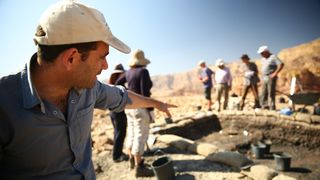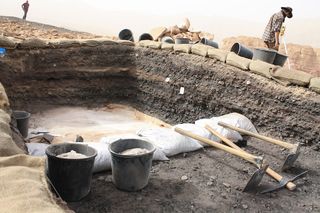New Clues To King Solomon's Mines Found

New evidence that links the vast copper mines in southern tip of Israel to the reign of King Solomon has been discovered, archaeologists report.
During the Iron Age, humans took advantage of the copper deposits lurking in Israel's Timna Valley, as evidenced by the thousands of ancient mines and dozens of smelting sites in the district. But archaeologists have debated who controlled the mines, and when.
After American archaeologist Nelson Glueck explored the region in the 1930s, he announced he had found the real-life "King Solomon's Mines" in the biblical kingdom of Edom. ("King Solomon's Mines" was a popular Victorian adventure novel, published by the English author H. Rider Haggard.)
Later research — and the 1969 discovery of an Egyptian temple in the center of the valley — cast doubt on Glueck's claims. Some archaeologists have since favored an interpretation suggesting the ancient Egyptians first built the mines in the 13th century B.C. [In Photos: Amazing Ruins of the Ancient World]

But recent excavations at Timna Valley turned up artifacts that have been radiocarbon dated to the 10th century B.C., when the Bible says King Solomon ruled.
The mines, however, were likely operated by the Edomites, a semi-nomadic tribe that battled constantly with Israel, the researchers say.
"The mines are definitely from the period of King Solomon," archaeologist Erez Ben-Yosef of Tel Aviv University, said in a statement this week. "They may help us understand the local society, which would have been invisible to us otherwise."
Sign up for the Live Science daily newsletter now
Get the world’s most fascinating discoveries delivered straight to your inbox.
This past winter, Ben-Yosef and a team of researchers investigated an area known as Slaves' Hill, a previously untouched smelting camp that holds traces of hundreds of furnaces and layers of copper slag, the grit that's left over after the metal is extracted from its ore.
The site lacks significant architectural ruins, but the researchers found more ephemeral traces of ancient life: bits of clothing, woven ropes, dates, grapes, pistachios and ceramics.
Eleven samples of material from Slaves' Hill were submitted for testing at the Oxford Radiocarbon Accelerator Unit at the University of Oxford in England. The results showed that the ancient items dated to Solomon's reign, the researchers said.
"In Timna Valley, we unearthed a society with undoubtedly significant development, organization, and power," Ben-Yosef said in a statement. "And yet because the people were living in tents, they would have been transparent to us as archaeologists if they had been engaged in an industry other than mining and smelting, which is very visible archaeologically."
Despite debate about how much archaeologists can trust the Bible as a historical source, Ben-Yosef added that it's very possible David and Solomon existed and at times, may have even exerted some control over the Timna Valley mines.
Ben-Yosef told LiveScience in an email that the team plans to submit their findings to a peer-reviewed academic journal. The new radiocarbon dates are in line with the chronology Ben-Yosef and other researchers put forth last year in the journal American Schools of Oriental Research. That 2012 study was based on findings from a nearby mining site.
Follow Megan Gannon on Twitter and Google+. Follow us @livescience, Facebook & Google+. Original article on LiveScience

